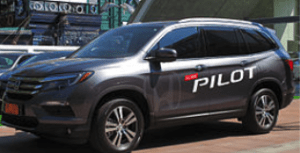Your Honda Pilot’s TCS light has two functions. The first function is to let you know that the Traction Control System (TCS) has been engaged. When it is actively engaged, it applies the brakes to whatever wheel is losing traction to help you maintain control over your Pilot. The second function is to let you know that there is something wrong with the TCS system.
If the TCS light is flashing, that is normal and indicates that the system is actively engaged in helping to eliminate wheel spin. It’s when it stays on for a long period of time that there’s a problem.
Flashing for a short period of time = Actively Working
Stays on for a long period of time = Problem
Resetting the TCS Light: Honda Pilot
In order to turn off the TCS light, you’ll need to pull over somewhere safe and reset the system. In order to reset the light, you simply need to restart your Pilot’s engine. If that doesn’t reset it, you’ll need to look at it or have it looked at.
There should be a TCS switch on your Honda. Locate it and make sure that it hasn’t been accidentally bumped. If it’s been manually turned off, the TCS light will stay on. It’s happened enough that it is worth mentioning.
Pilot TCS Light On Symptoms
You shouldn’t really notice any sort of symptoms other that the TCS light during normal driving conditions. The exception to that would be when there would be a need for traction control. Your vehicle will slide and could potentially crash.
TCS Light on Causes: Honda Pilot
Here are some of the most common reasons that you would get the TCS Light on in your Honda Pilot:
1. TCS Switch Bumped
If the TCS switch has been accidentally bumped, the traction control system will deactivate. Until it has been reactivated, the light will turn on and stay on. This seems so obvious, but it happens all the time.
2. Overheated Brakes
If the TCS system has been activated a lot, or if you are driving in extremely tough conditions, you can overheat the brakes. When this happens, the traction control system will deactivate until the brakes reach the proper temperature. The TCS light will come on until the brakes have cooled.
3. Wheel Speed Sensor(s)
The wheel speed sensors measure the speed of each of your Pilot’s wheels. When the data from the sensors indicate that one of the wheels is turning faster than the other wheels, the TCS system will engage and slow the slipping wheel back down.
The TCS light will often come on with the ABS light as well when a wheel speed sensor has gone bad. If the check engine light is on as well, get a OBD-II scanner and see if the stored codes are wheel speed related. In fact a good scanner can save you a lot of time and tell you exactly why the light is on.
Honda Pilot: ABS Light Diagnosis
The ABS system is needed for the TCS system to function, so if there is something wrong with it the TCS system won’t work.
4. Bad TCS Computer
The TCS computer uses all of the data from the various speed sensors and uses that to activate the braking system and keep the vehicle stable. If the computer can no longer interpret this data that the TCS light will come on and there will be no traction control until it has been fixed.
Can You Drive With TCS On?
Your Honda Pilot will run and drive fine without the traction control system. On a normal dry day or week the system may not be needed. You never know when it will be needed, but you won’t be as safe without it. With that in mind we recommend having the system repaired without delay. Drive carefully until you can get it into a shop.
Conclusion: Pilot TCS Light On
The TCS light can come on for a variety of reasons, usually the wheel speed sensors are at fault. Good luck diagnosing the problem. If there is anything that you would like to help people with their Honda Pilot TCS issues, please leave a comment below.


